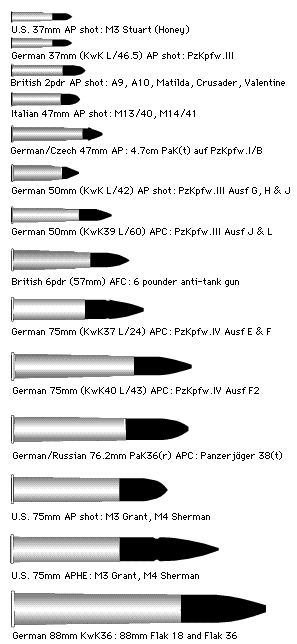
| Shown on the left is a selection of ammunition which played a prominent role in the desert battles.
They are not meant as perfect representation of the
round, but more a method of presenting a comparative
mental picture of the approximate size of each.
An immediate comparison between the British 2 pounder AP shot and the 88mm shell at the bottom speaks volumes. The British 2pdr (capable of firing AP shot only) and US 37mm were both limited to a range of 500 yards or under for effective penetration, the 2pdr piercing about 58mm of 30 degree homogenrous plate, and the 37mm defeating about 48mm. The German L/60 50mm round falls in the mid-range, and as a tank gun or in the anti-tank mode on its field mounting and firing APC capped shot it was capable of destroying most British and American built tanks of this period.
The main German AP round (Pzgr) contained a small HE charge, but the same gun could also fire ordinary HE (Spgr) ammunition. Once the 50mm gun appeared with its capped APC round, armor penetration at longer ranges was greatly increased. There was also a special AP40 (Pzgr 40) used by the German tanks and ainti-tank guns, but it was in very short supply. The AP40 had a mild steel body with a tungsten-carbide core and light alloy ballistic cap. The Muzzle velocity was very high, but dropped off rapidly, so the increased penetration was only obtained at shorter ranges. In this regard it was mainly reserved for use against the heavily armored British infantry tanks.
The 75mm gun of the M3 Grant fired both HE and AP rounds, but in the early battles these rounds left much to be desired. Designed for high angle fire, their fuse settings required impact on an almost vertical surface. If fired on a flat trajectory the fuze often failed to fire on impact, and the round would end up skipping across the desert. This was eventually corrected by replacing the original with French WWI fuses, scavenged from a 90,000 round stockpile located by the British in Syria. The interim AP M72 round was found to be relatively ineffective against German frontal armor at ranges over 500 yards, but with the conversion of German 75mm APCBC rounds and the arrival of the new APC M61 the problem was finally solved.
George Bradford
|
